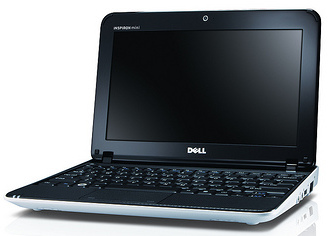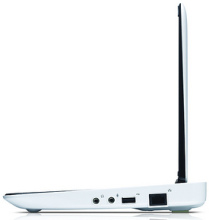Dell netbook gets accelerated video
Feb 26, 2010 — by LinuxDevices Staff — from the LinuxDevices Archive — 3 viewsDell announced an “Performance Plus” version of its Inspiron Mini 10 netbook, including a 1366 x 768 display, a Broadcom “Crystal HD” media accelerator, and a six-cell battery. The Ubuntu-ready Mini 10 also gets up to 9.5 hours of battery life, the company says.
Dell's first Mini 10 ran on Intel's "Silverthorne" Atoms, the Z520 (1.33GHz) or Z530 (1.6GHz). In December, however, the system was upgraded to the newly announced "Pineview" Atom, the N450. Although clocked about the same as the Z530 at 1.66GHz, the N450 saves on space and power consumption by incorporating a memory controller and graphics core, the GMA 3150.
Dell claimed at the time that the revised Mini 10 would get up to 9.5 hours of battery life with an optional six-cell battery. Also touted was a redesigned keyboard with sculpted keys and "a textured, smudge-resistant palm rest." according to Dell.

Dell's revised Mini 10
Now, in the newly announced "Performance Plus" edition, the Mini 10 gets the six-cell battery as standard equipment, according to Dell. More significant, the device's 10-inch display is upgraded to 1333 x 768 pixels, and the recently announced Broadcom Crystal HD (BCM70015) media accelerator is also part of the package, the company says.
The single-chip video processor is said by Broadcom to provide HD and SD video playback of standard codecs (H.264/AVC, MPEG-2, VC-1, WMV9, MPEG-4, DivX, Xvid and AVS) "with no frame drops or jitter, even under a heavy CPU load."
According to Dell "chief blogger" Lionel Menchaca, the Performance Plus version of the Mini 10 provides "optimized HD video" via the latest Beta 3 edition of Adobe's Flash 10.1 software. It's said the device can play back 1080p video from YouTube and other sites without dropping frames, as demonstrated in the Engadget story embedded at the end of this story.

Color choices available with the Mini 10
Apart from the battery, display, and graphics updates, the Performance Plus version of the Mini 10 also includes Bluetooth and gets a 250GB hard disk drive instead of the standard 160GB, according to Dell. The netbook also comes with Windows 7 Starter Edition instead of the previously offered Windows XP, the company adds.
Not such a great deal for Tux?
The above discussion of Windows obliges us to point out that, while Ubuntu-equipped versions of the Mini 10 have been promised, there does not appear to be any way to get the Performance Plus version of the netbook without paying the "Microsoft Tax." Additionally, in its release notes for Flash Player 10.1 Beta 3, Adobe says H.264 hardware acceleration is not supported under Linux, charging that "Linux currently lacks a developed standard API that supports H.264 hardware video decoding."
Broadcom says it is committed to the development of Linux media players that benefit from the Crystal HD media accelerator. In December, the company released relevant kernel driver source code under the GNU General Public License (GPL), version 2. Despite this, we'd guess that users who want to tap into the Mini 10's 1080p video playback will have to dual-boot into Windows for some time to come.


Side views of Dell's Mini 10
(Click on either to enlarge)
Some configurations of the Mini 10 are also offered with either a TV tuner or a GPS receiver. These options do not appear to be available on the Performance Plus version, however, perhaps because the Broadcom accelerator occupies a Mini PCI Express slot.
The Mini 10 playing back HD video
Source: Engadget (click to play)
Availability
The Performance Plus version of the Dell Inspiron Mini 10 appears to be available now for approximately $410. More information may be found at the Dell Online Store, here.
Adobe's Beta 3 edition of Flash Player 10.1 is downloadable here. Linux kernel driver source code for the Crystal HD media accelerator may be found on the Broadcom website, here.
Lionel Menchaca's blog posting regarding the Performance Plus-equipped Mini 10 may be found here.
This article was originally published on LinuxDevices.com and has been donated to the open source community by QuinStreet Inc. Please visit LinuxToday.com for up-to-date news and articles about Linux and open source.